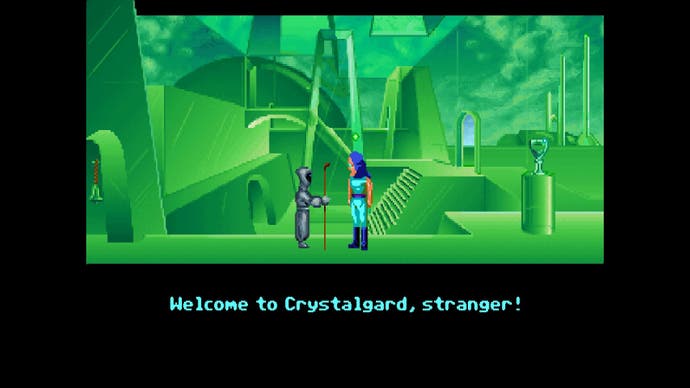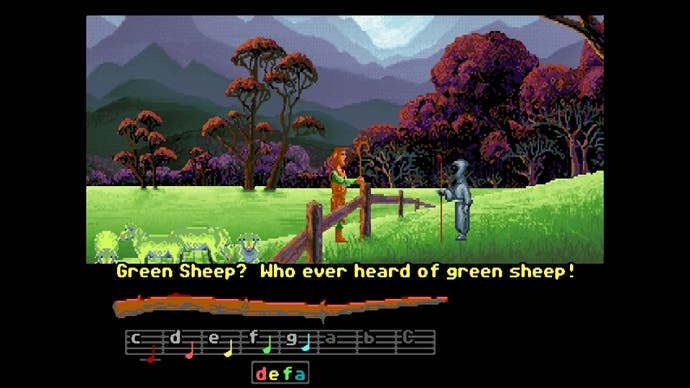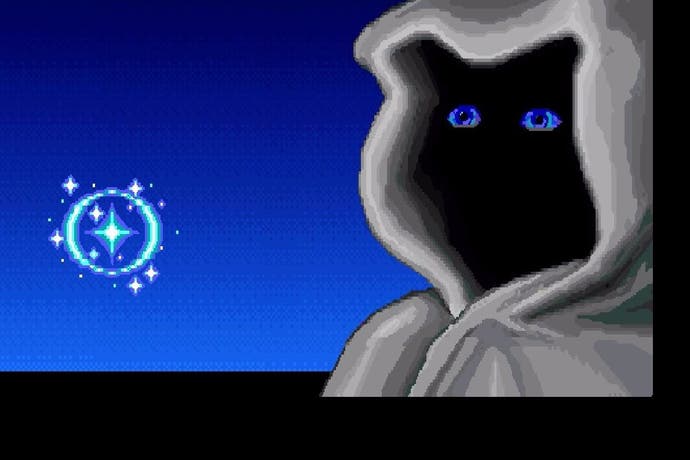Remembering Loom, the adventure game designed to be completed
Delicately woven.
After signing up to write this retrospective, it dawned on me that I might not have time to replay Loom. I looked at my schedule and saw that I'd left myself a single evening in which to struggle through a 90s LucasArts adventure. You know, those games notorious for their fiendishly difficult puzzles and dozens of red herrings. I still have nightmares about that forest in Grim Fandango.
But it's been so long since I last played Loom I'd forgotten that Loom was designed to be completed. This phrase was written in the manual when the game released in 1990, and recently reiterated by Brian Moriarty during Loom's 25th anniversary GDC lecture . For someone struggling to fit more and more games into less and less free time, hearing those words is like a spoonful of ambrosia.
Loom was designed to be completed. Yet this isn't what makes it exceptional. That stems from how LucasArts set about implementing the idea, lacing it through the game like a thread through a tapestry. Loom took all the elements of LucasArts adventures up to that point; storytelling, humour, contextual interaction and puzzles - along with a brand new element - sound, and wove them together using a single system that even today astounds through its simple, exquisite ingenuity. Loom is not only the name of the game or the subject of the story. It's a concept that influences every facet of the design.
This idea is embodied most of all by the distaff. In all LucasArts adventures prior to Loom (and many adventures after) the player interacted with the world through a range of canned actions. Push, Pull, Talk To, Look At, Open, Close, and so on. It was a clever way of sustaining the illusion having more choice in the world than players actually did; revealed by the dozens of witty variations upon "I can't do that" when the player performed an action the designers didn't anticipate.

It was also extraordinarily convoluted, made more so when combined with items that could be baffling in their function ("A rubber chicken with a pulley in the middle?!") This was perfect for a side-splitting comedy game where getting things wrong was half the fun, but less practical for a whimsical fantasy adventure designed to be completed.
In Loom, the distaff unifies all of these actions. The distaff has a musical scale magically imbued along the length of its handle. Playing four notes in a particular order casts a "draft"; a spell that affects the world. These range from the mundane (bleaching wool) to the bizarre (turning straw into gold) and the apocalyptic (ripping a hole in the fabric of the universe).
In theory, the distaff can do anything. Indeed, the "Book of Patterns" supplied in the original game box included descriptions of drafts that weren't actually present in Loom. In his lecture, Moriarty explains that figuring out which drafts could be used was intended as part of the puzzle. But they also hint at the distaff's wider ability. Because the distaff can do anything, the player immediately knows that any puzzle they encounter in Loom will use it. This also means you don't need to carry items around. Why bother when you can change straw into gold?
The distaff ensures that the solution to a puzzle is always at hand, and that each puzzle will follow the same logical rules. One of my favourite touches is that triggering opposing effects, say, emptying and filling a vessel, simply involves playing the same draft in reverse. Not only does this make the player feel smart when they figure it out, it also halves the number of drafts they need to learn. Like Portal 2's portal gun or Half-Life 2's gravity gun, Loom's distaff ties everything together, the object from which all design threads spin. Infusing thematic depth at a systemic level is something that very few games achieve.

Every aspect of Loom follows this pattern, and its setting is no different. Loom takes place during the Age of the Great Guilds, where civilisation has separated into clearly defined city states, each specialising in a particular trade such as glassblowing, blacksmithing, or shepherding. It's a highly organised world, carefully knitted together. But there's a kink in the pattern; the Guild of Weavers, who quickly grew tired of making woolly hats and cashmere skirts, and started spinning the threads of reality instead.
Eventually this cosmic crocheting results in Bobbin Threadbare, who is drawn as a newborn straight from the Weavers reality-spinning Loom by his bereaved mother, Cygna. Hypocrites to the core, the Weavers fear Bobbin's link to the Loom, and refuse to teach him their ways. Loom's story begins on Bobbin's 17th birthday, when the Weavers discover one of their number, Hetchel, has been teaching Bobbin in secret. As they exact their punishment on this rogue tutor, a swan crashes through a tear in reality, and transforms the other weavers into fellow arm-breaking, royally protected birds. Flying off in panic, they leave Bobbin alone with the distaff, and one heck of a mystery on his hands.
I love the game's approach to storytelling, relying more on situation than rigorous plot. It lets the story spool out as it were being ad-libbed by travellers huddled around a campfire, or whispered by a grandmother to wide-eyed grandchildren. The tone equally well judged. Loom is laced with that cheeky LucasArts wit. Yet the punchlines tend to be slightly softer, better to blend with the strip of darkness running through the tale.

Playing Loom today is like scrubbing off 25 years of accumulated dirt. In an age where games seem increasingly burdened by overwrought systems and arbitrary design fluff, Loom's simplicity and clarity of direction is extremely refreshing. It's also very well preserved, aided greatly by two factors. First is the wonderful background art drawn by fantasy artist Mark Ferrari, whose expert use of dithering transforms Loom's sixteen-colour palette into a thousand subtle shades. The emerald corridors of the glassblowers' metropolis remains a wondrous sight to behold, even now in the days of pixel shaders and real-time global illumination.
The other contributor is the superb voice acting, which was included in the 1992 CD-ROM version, two years after the original release. The use of chirpy British voice-actors lends the game a Pythonesque vibe, softening those darker edges just the right amount. The advent of CD-ROMs also allowed a far more complex musical score, adding extra layers to George Sanger's midi arrangement of Tchaikovsky's motifs.
Perhaps fittingly, Loom's unravelling tale concludes with a lot of loose ends, and the planned sequels to tie up those threads never happened. The notion that Loom sold poorly is a myth. Moriarty simply moved on to other projects, and a cull of LucasArts producers in the early 90s meant Forge fell by the wayside. Lost sequels are always tantalising, but part of me is glad that Loom stands alone as a slice of a larger, unseen story, a crescent moon in a deep blue sky. After all, Loom was designed to be completed, and if that wasn't the case, you'd be reading a much shorter retrospective.









